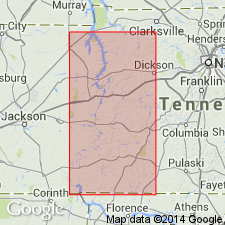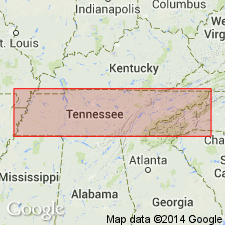
- Usage in publication:
-
- Quall limestone
- Modifications:
-
- Named
- Dominant lithology:
-
- Limestone
- AAPG geologic province:
-
- Upper Mississippi embayment
Summary:
Quall limestone named in Hardin Co., southwestern TN. Described as heavy-bedded fine-grained cherty gray limestone in layers 18 to 20 in. thick. Weathers to very porous, rotten white and buff chert with yellow clay. Thickness 0 to 10+/-ft. Fauna clearly upper Oriskany. Lies unconformably above Decaturville chert and unconformably below Harriman chert. Confined to southern part of State.
Source: GNU records (USGS DDS-6; Reston GNULEX).

- Usage in publication:
-
- Quall limestone
- Modifications:
-
- Not used
- AAPG geologic province:
-
- Upper Mississippi embayment
Summary:
Pg. 307. Quall limestone. Erosion following flooding of Pickwick Lake has exposed section of 40 feet of Harriman limestone just across valley from old Quail place --type locality of Quail limestone. On basis of recent studies, it is concluded that Dunbar's Quail limestone is an unweathered phase of Harriman formation, and it is recommended that name Quail be discontinued.
Source: US geologic names lexicon (USGS Bull. 1200, p. 3169).
For more information, please contact Nancy Stamm, Geologic Names Committee Secretary.
Asterisk (*) indicates published by U.S. Geological Survey authors.
"No current usage" (†) implies that a name has been abandoned or has fallen into disuse. Former usage and, if known, replacement name given in parentheses ( ).
Slash (/) indicates name conflicts with nomenclatural guidelines (CSN, 1933; ACSN, 1961, 1970; NACSN, 1983, 2005, 2021). May be explained within brackets ([ ]).

